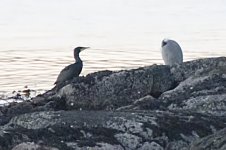Hi!
I was watching some birds the other day (west coast Norway), which I can't make up my mind about whether is grear cormorant or european shag. Both are known to be in the area. I would perhaps suspect them to be cormorants, as I've heard that they can often be found at that spot, but how do I tell? I can't decide from the drawings in my bird guide.
I was watching some birds the other day (west coast Norway), which I can't make up my mind about whether is grear cormorant or european shag. Both are known to be in the area. I would perhaps suspect them to be cormorants, as I've heard that they can often be found at that spot, but how do I tell? I can't decide from the drawings in my bird guide.











